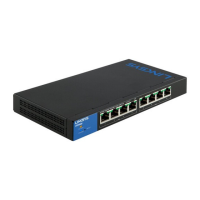104
Table of Contents
Linksys
Table of Contents
Linksys
• Result—Success or fail of ping.
• Number of Pings Sent—Numbers of responses sent.
• Number of Ping Responses Received—Numbers of responses received.
• Packets Lost—Numbers of responses not received
• Minimum Round Trip Time—Minimum time passed between sending of
packets and reception of responses.
• Maximum Round Trip Time—Maximum time passed between sending of
packets and reception of responses
Average Round Trip Time—Average time passed between sending of packets
and reception of responses
Traceroute
Traceroute discovers the IP routes along which packets were forwarded by
sending an IP packet to the target host and back to the device. The Traceroute
page shows each hop between the device and a target host, and the round-
trip time to each such hop.
STEP 1 Click Maintenance > Diagnostics > Traceroute.
STEP 2 Configure Traceroute by entering information into the following
fields:
• Target—Select whether target hosts are identified by their IP address or
name.
• IP Version—If the target host is identified by its IP address, select either
IPv4 or IPv6 to indicate that it will be entered in the selected format.
• IPv6 Address Type—Select the IPv6 address type (if IPv6 is used). The
options are:
• Link Local—The IPv6 address uniquely identifies hosts on a single
network link. A link local address has a prefix of FE80, is not routable,
and can be used for communication only on the local network. Only
one link local address is supported. If a link local address exists on
the interface, this entry replaces the address in the configuration.
If this mode Global—The IPv6 address is a global Unicast IPV6 type
that is visible and reachable from other networks. Select the link local
interface (if IPv6 is used) from the list.
• Target IP Address—Select the target source interface whose IPv4 address
will be used as the source IPv4 address for communication messages.
Only the existing IP addresses of the type specified in the IP Version field
will be displayed.
• Target Name—Enter the target host name.
• TTL—Enter the maximum number of hops that Traceroute permits. This is
used to prevent a case where the sent frame gets into an endless loop. The
Traceroute command terminates when the destination is reached or when
this value is reached. To use the default value (30), select Use Default.
• Timeout—Enter the length of time that the system waits for a frame to
return before declaring it lost, or select Use Default.
STEP 3 Click Start. The operation is performed.
A page appears showing the Round Trip Time (RTT) and status for each trip in
free text containing the following information:
• Index—Displays the number of the hop.
• Host—Displays a stop along the route to the destination.
• Round Trip Time (1-3)—Displays the round trip time in (ms) for the first
through third frame and the status of the first through third operation.
Port Mirroring
Port mirroring is used on a network device to send a copy of network packets
seen on one or multiple device ports, to a network monitoring connection on
another port on the device. This is commonly used for network appliances that
require monitoring of network traffic, such as an intrusion-detection system. A
network analyzer connected to the monitoring port processes the data packets
for diagnosing, debugging, and performance monitoring. Up to four sources
can be mirrored. This can be any combination of four individual ports.
A packet that is received on a network port assigned to a VLAN that is subject
to mirroring is mirrored to the analyzer port even if the packet was eventually
trapped or discarded. Packets sent by the device are mirrored when Transmit
(Tx) mirroring is activated.
Mirroring does not guarantee that all traffic from the source port(s) is received
on the analyzer (destination) port. If more data is sent to the analyzer port
than it can support, some data might be lost.
Only one instance of mirroring is supported system-wide. The analyzer port is
the same for all the mirrored ports.

